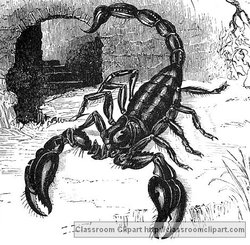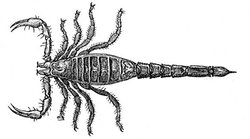Scorpion
|
|
| Scorpion | ||||||||||
|---|---|---|---|---|---|---|---|---|---|---|
 Scorpion | ||||||||||
| Scientific classification | ||||||||||
|
A scorpion is an invertebrate animal with eight legs belonging to the order Scorpiones in the class Arachnida.
| Contents |
Physical characteristics
The scorpion body is divided into 2 main segments the cephalothroax and the abdomen, the cephalothroax consists of the prosoma and the abdomen of the mesosoma and the metasoma;
Prosoma: the “head” of the scorpion comprising the carapace, eyes, chelicera (mouth parts) and pedipalps (claw).
Mesosoma: The main body of the scorpion contains its lungs, digestive tract and sexual organs. The 4 pairs of walking legs (a common feature of the arachnids) are attached to this section as well as the pectines (featherlike sensory organs). The mesosoma is armoured with chitinous plates, on the upper surface by the tergites and on the lower surface by the sternites
Metasoma: The tail of the scorpion, comprised of 5 segments, the last contains the anus of the scorpion and bears the telson (the sting) which comprises of the vesicle which holds a pair of venom glands, and the hypodermic aculeus, the barb used to inject the venom.
Main Scorpion Physical Features:
Pedipalps: these are a pair of modified legs that have evolved into claws. The claws are used primarily for prey capture, but also play an important part in the scorpion mating dance. The pedipalps are made of up of 6 segments. The claw itself consists of the upper fixed finger (tibia) and the lower moveable finger (tarsus). The size of the pedipalps is highly dependant on the species, however a general trend is that the more venemous the scorpion the narrower the pedipalps, as scorpions with less potent venom use their larger pincers to subdue prey.
Pectines: These are a pair of feather like sensory organs, consisting of a row of pegs, and are unique in scorpions. The pectines are located beneath the scorpion attached to the sternum. They constantly touch the ground and play an important role in the scorpion’s sensory equipment. The pectines are covered in thousands of chemosensors that allow the scorpion to detect minute chemical signals in their environment; they probably play an important role in social interaction, mating and hunting.
Eyes: Scorpions in general have three sets of eyes, one pair located in the top centre of the carapace are called the median eyes. There are two more sets of lateral eyes on either side of the front of prosoma, the number varies between species. Some species of cave dwelling scorpions however have no eyes, relying purely on their other senses. Scorpion’s eyes are simplistic organs, only able to detect regions of strongly contrasting light intensity, such as horizons. The eyes are however very sensitive; some have theorised that they even allow the scorpion to navigate by star light, and they are important in regulating the scorpions circadian rhythm. It is doubtful as to whether they are used in prey capture.
Scorpion venom
All species of scorpion possess venom. In general scorpion venom is described as neurotoxic in nature. It consists of a variety of small proteins as well as sodium and potassium cations, which serve to interfere with neurotransmission in the victim. Scorpions use their venom to kill or paralyze their prey so that it can be eaten; in general it is fast acting, allowing for effective prey capture.
Scorpion venoms are geared towards activity in other arthropods and therefore most scorpions are relatively harmless to humans; stings produce only local effects (such as pain, numbness or swelling). However a few scorpions, mostly in the family Buthidae, can be dangerous to humans. Among the most dangerous are Leiurus quinquestriatus, which has the most potent venom in the family, and members of genus Parabuthus, Tityus and Androctonus whose venom is also strong. These scorpions and others in the family Buthidae have been responsible for many deaths, although scorpions are generally unable to deliver enough venom to kill healthy adults; deaths normally occur in the young, elderly or infirm. Unless molested, scorpions are perfectly harmless, and only make use of the sting for the purpose of killing prey. Generally, they will run from danger, or remain very still. It is unknown whether scorpions are venom conservers, however often the venom is not used unless the prey cannot be subdued with the claws. Many species of scorpions such as Pandinus and Hadogens rarely, if ever, use their venom, instead relying on their strong bulky pedipalps in prey capture.
Suicide myth
The belief that scorpions commit suicide by stinging themselves to death when surrounded by fire is of considerable antiquity and is often prevalent wherever these animals occur. It is nevertheless untrue, since the venom has no effect on the scorpion itself, nor on any member of the same species (unless the venom is injected directly into the scorpion's nerve ganglion). The myth derives from the fact that scorpions are ectotherms, when exposed to intense heat their metabolic processes malfunction. This causes the scorpion to spasm wildly and this spasming may appear as as if the scorpion is stinging itself, hence the derivation of the myth.
Growth
Unlike the majority of Arachnida, scorpions are viviparous. The young are born two at a time, and the brood, which consists of a dozen or more individuals, is carried about on its mother's back until the young are large and strong enough to care for themselves. The young in a general way resemble their parents and undergo no metamorphosis with growth, which is accompanied by periodical casting of the entire skin. Moulting is effected by means of a split in the integument which takes place just below the edge of the carapace all round, exactly as in kingcrabs, spiders and Pedipalpi. Through the split the young scorpion gradually makes its way, leaving the old integument behind.
Origins
Scorpions are of great antiquity. Their remains are often found in coal deposits of the Carboniferous Period, and no essential structural difference has been discovered between these fossils and existing forms—a fact proving that the group has existed without material structural modification for millions of years. These Carboniferous scorpions were preceded by others, now occurring in marine Silurian deposits, which evidently lived in the sea and exhibit some anatomical differences marking them off as a group distinct from their Carboniferous and recent descendants and attesting affinity with the still earlier marine Arachnida referred to the group Gigantostraca. Their legs were short, thick, tapering, and ended in a single strong claw, and were well adapted, it seems, like the legs of shore-crabs, for maintaining a secure hold upon rocks or seaweed against the wash of waves. The method of breathing of these ancient types is not certainly known; but probably respiration was effected by means of gills attached to the ventral plates of the body. At all events no trace of respiratory stigmata has been detected even in well-preserved material. These Silurian scorpions, of which the best-known genus is Palaeopzonus, were of small size, only two to five centimeters in length.
Geographical distribution
Scorpions are almost universally distributed south of 45°N and their geographical distribution shows in many particulars a close and interesting correspondence with that of the mammals, including their entire absence from New Zealand. The facts of their distribution are in keeping with the hypothesis that the order originated in the northern hemisphere and migrated southwards into the southern continent at various epochs, their absence from the countries to the north of the above-mentioned latitudes being due, no doubt, to the comparatively recent glaciation of those areas. When they reached Africa, Madagascar was part of that continent; but their arrival in Australia was subsequent to the separation of New Zealand from the Austro-Malayan area to the north of it. Moreover, the occurrence of closely related forms in Australia and South America on the one hand, and in tropical Africa and the northern parts of South America on the other, suggests very forcibly that South America was at an early date connected with Australia by a transpacific bridge and with Africa by a more northern transatlantic tract of land.
In conformity with their wide dispersal, scorpions have become adapted to diverse conditions of existence, some thriving in rainforests, others on open plains, others in sandy deserts, and a few even at high altitudes where the ground is covered with snow throughout the winter. In the tropics they aestivate at times of drought; and in the Alps they pass the cold months of the year in a state of hibernation.
In the United States, scorpions are most common in southern Arizona and in a swath extending through central Texas and central Oklahoma. The common striped scorpion Centruroides vittatus reaches from northwest Mexico to southern Colorado, Kansas, southern Missouri and Mississippi. Species of the genus Vaejovis are found from Florida north to Maryland, the Carolinas, and Tennessee.
How scorpions eat
Scorpions first catch their prey in their claws. If their prey is strong, they will paralyze it with their stinger. They then tear off a bit, digest it, and shoot acids out to dissolve the prey. They then suck up the prey. A meal usually takes a couple of hours.
Scorpions and humans
Scorpions and humans have shared a troublesome relationship. Scorpions often invade living quarters, hiding in clothing and causing injury. The north African species Androctonus australis is considered to be among the most dangerous species, and is responsible for a disproportionately high number of debilitating stings and deaths, particularly in Algeria and Tunisia.
Species found in the United States (usually of the genus Centruroides) are relatively safe, and are likened to a wasp sting. The victim should stay calm. Medical attention is usually necessary only for infants and the elderly, or when there is difficulty breathing. Ice applied to the sting curbs the pain immediately, though some suggest ammonia is a panacea.
Scorpions are hunters, and infested houses are usually the result of a scorpion finding easy routes inside. The house is best treated by meticulously sealing and weatherstripping all cracks, door frames, baseboards, and other points of entry, both inside and outside, and treating for any insects inside the house to eliminate the food chain. Homeowners should then use a fluorescent blacklight outdoors just after dark. The scorpions glow brightly, and their presence helps determine how well established they are and where they are breeding. Problems are often traced to woodpiles, rocky bare ground, and debris, and these areas can be rectified by cleaning and establishing a dense lawn around the perimeter of the house. Residents in endemic areas should adapt the habit of shaking out all shoes, bedding, and clothing before use.
A few scorpions are docile enough to be handled and kept as pets. The most common of these is the emperor scorpion, an African species with fairly mild venom. Most scorpions, however, are more aggressive and/or have more potent venom.
Clipart and Animal Pictures
- Clipart (https://classroomclipart.com/image/category/clipart.htm)
- Animal Clipart (https://classroomclipart.com/image/category/animal-clipart.htm)
- Animal Animated Clipart (https://classroomclipart.com/clipart/Animations/Animals.htm)
- Pictures of Animals (https://classroomclipart.com/image/category/animal-photos.htm)
- Amphibian Clip Art, Pictures and Photogaphs (https://classroomclipart.com/image/category/amphibian-clipart.htm)
- Farm Animal Clip Art, Pictures and Photographs (https://classroomclipart.com/image/category/farm-animal-clipart.htm)
- Mammal Clip Art, Pictures and Photographs (https://classroomclipart.com/image/category/mammal-clipart.htm)
- Marine Animal Clip Art, Pictures and Photographs (https://classroomclipart.com/image/category/marine-life-clipart.htm)
- Reptile Clip Art, Pictures and Photographs (https://classroomclipart.com/image/category/reptile-clipart.htm)
- Spider Clip Art, Pictures and Photographs (https://classroomclipart.com/image/category/spider-clipart.htm)
- Pictures of Scorpions (http://classroomclipart.com/cgi-bin/kids/imageFolio.cgi?direct=Animals/Scorpions)



